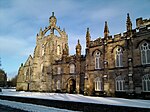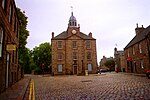University of Aberdeen School of Law

The University of Aberdeen School of Law (Scottish Gaelic: Sgoil Lagha Oilthigh Obar Dheathain) is the law school of University of Aberdeen, located in Aberdeen, Scotland. Established in 1495, it has been consistently ranked among the top 10 law schools in the United Kingdom.Today, it is one of the oldest, largest and selective law schools in Scotland, admitting some two hundred and fifty students each year, as well as over forty international exchange students. The 2021 Complete University Guide league rankings placed Aberdeen at 6th in the UK. The 2019 The Times league rankings also placed Aberdeen at 7th in the UK.The School offers both undergraduate (LL.B.) and taught and research postgraduate degrees (LL.M.), as well as the Diploma in Legal Practice and Professional Competence Course. The current Head of the School of Law is Prof. Dr. Greg Gordon.
Excerpt from the Wikipedia article University of Aberdeen School of Law (License: CC BY-SA 3.0, Authors, Images).University of Aberdeen School of Law
Wrights' and Coopers' Place, Aberdeen City Old Aberdeen
Geographical coordinates (GPS) Address Website Nearby Places Show on map
Geographical coordinates (GPS)
| Latitude | Longitude |
|---|---|
| N 57.165277777778 ° | E -2.1011111111111 ° |
Address
University of Aberdeen (Aberdeen University;University of Aberdeen - Old Aberdeen Campus;University of Aberdeen - King's College)
Wrights' and Coopers' Place
AB24 3EZ Aberdeen City, Old Aberdeen
Scotland, United Kingdom
Open on Google Maps







